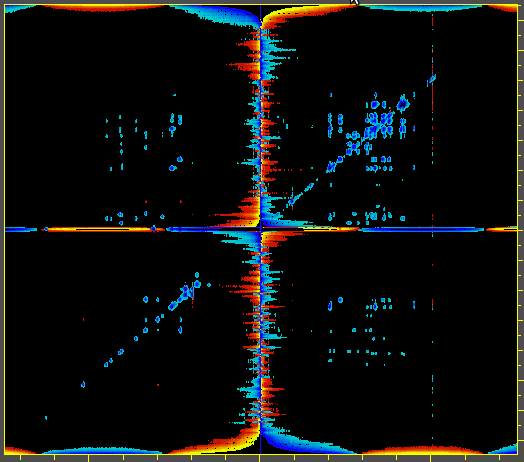|
Here is a TOCSY recorded with States-TPPI method on a sample in 10/90 D2O/H2O. States-TPPI is expected to move the "horizontal" solvent artifact to the edges. It does in fact remove most of it, but there is still a considerable residual horizontally running streak. Are there ways to reduce it by tweaking experimental parameters/pulse sequence? edit: the water suppression scheme is DPFGSE excitation sculpted watergate. Thanks!
|
|
The water-suppression scheme is not specified. The pulse sequence and phase cycling used is also not specified. A complete phase-cycle including both cyclops and axial suppression may improve the spectrum although states-tppi does shift the zero-frequency peaks to the edge. However, it is likely that the complete phase cycle was used in this experiment and the problem lies elsewhere. The most important experimental parameter that determines the quality of water suppression is the homogeneity of the magnetic field. Therefore, shims should be adjusted. However, even if your 1D looks pretty good, your 2D TOCSY may still have extensive residual water, due to two reasons - incomplete saturation due to poor line shape or inadequate power, or due to relaxation. Relaxation may occur either during the evolution period, the mixing period or during the detection period. Water suppression schemes such as watergate are particularly effective because the solvent suppression occurs just before the detection period. However, the high Q probes at high magnetic field can lead to rapid relaxation due to radiation damping - this can be significant even during the time required to apply the selective pulse in the watergate, i.e., relaxation occurs even while the selective pulse is being applied (selective pulses can be designed that take radiation damping into account). The horizontal artifact in your spectrum is not symmetric. This suggests the possibility of incorrect choice of irradiation frequency/ carrier frequency. If TOCSY is used with standard parameter set there is a slight increase in the temperature of the sample AFTER the beginning of the experiment, due to conversion of Rf energy into heat. This gives rise to a temperature gradient. The chemical shift of water is very sensitive to temperature, therefore, the absorption maximum is not the same for all water molecules in the sample. If this is the reason for the artifact, then the artifact may be reduced in the following way. Start the 2D experiment. After a steady state of thermal gradients is produced (about 5-10 minutes), stop the experiment. Quickly adjust shims and carrier frequency for optimum water suppression (also check water suppression and adjust receiver gain using the TOCSY sequence with the incrementable delay set to a non-zero value). Then restart the 2D with the standard parameters, preferably using a large number of dummy scans for the first increment. |






